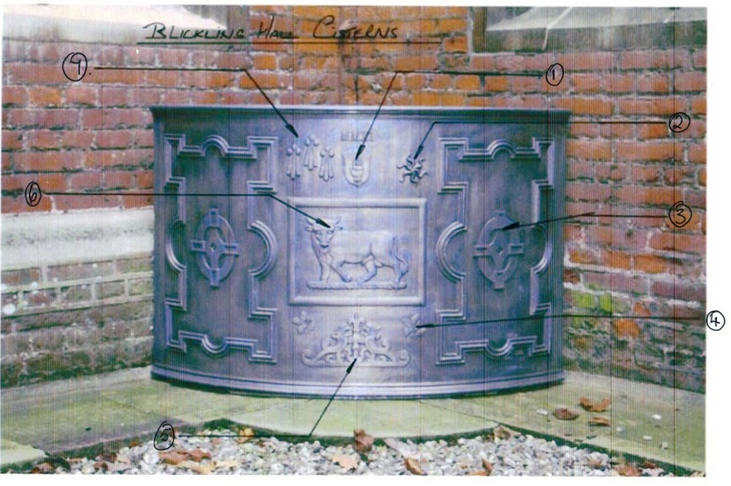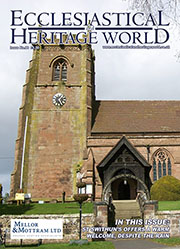Blickling Hall Cisterns by Turners Ornamental Leadwork

Brian Turner's brief at Blickling Hall was to make a planter - something that could go under a window about a meter wide and about 500mm X 600 deep.
On visiting the front entrance of Blickling Hall you approach down a long drive with a ewe hedge on both sides, which is huge and hundreds of years old, coming into an outer courtyard with wings on both sides. Then standing in front of you is a wonderful old wooden door leading into an inner court yard over a stone bridge.
Once in the courtyard, it is the ideal location for two corner planters/cisterns. The front panels are 1200mm long and 900mm tall and weigh 453 kilos. The two planters were designed using the ornamentation on the bridge and facade linking the planter / cistern to the hall. They could be there for 1,000 years plus as there are examples of lead work lasting 4,000 years. All casting have been cast in a sand bed.
Positioned using a tried and tested method - thin baton covered with tallow - they just slide gently into position.
The cast symbols have had special meanings for centuries, and in the Jacobean period when Blickling Hall was built, they were widely used in the decoration of their houses. It must be remembered however that sometimes the aim was purely decorative.
On the image, you will see either (S) for symbolic, or (D) for decorative against each of the numbered symbols.

1. Red Hand of Ulster (S)
The Red Hand of Ulster appears on the coat of arms of Henry Hobart, over the Entrance to Blickling, and also at various places throughout the house. In Heraldry, the Red Hand (always a left hand as depicted here) is the badge of a Baronet, and of course Henry Hobart, the builder of Blickling held that title. The symbol dates back to Pagan times, and is tied up with the ownership of land. We know that Hobart owned land in Ulster, so the symbol could also have referred to that fact.
There is an Irish legend which tells of a time when the Kingdom of Ulster had no rightful heir, so a boat race was devised - possibly on the Strandford Lough. The boats raced towards the land, and whosoever's hand was the first to touch the shore would be made King. One man was so determined to win, that when he saw he was losing the race, he cut off his hand and threw it on the shore - thus winning the Kingship.
2. Stylised Star or Flower? (D)
This is a difficult one, andis difficult to recognise. Possible simply for decoration. However, if it is a star it would signify divine guidance.
3. Jacobean Strap Work (D)
This is a typical example of what is known as 'strap work'. Often used to outline smaller symbols, it is said to resemble strips of leather - sometimes flat as shown here, or often twisted and folded. It was frequently used on both wood panelling and the highly omate plaster ceilings of the period. It is lavishly used throughout Blickling Hall.
4. Oak Leaves (S)
This is, of course, the National Trust Symbol, but is also to be found in the borders of the Mortlake Tapestries at Blickling. The oak leaves stand for strength and protection.
5. Two Exotic Birds (S)
Difficult to say exactly but possibly parrots. There was great interest in exotic birds and animals following the discovery of The Americas. Birds represented spirits, divine manifestations allowing entry into heaven. The symbol of Fleur-de-Lys at the top, can stand in religious terms for the trinity, and is often associated with France. However, it also stands for a spear, a defence against intruders, and has been used on the British Royal standard since the time of James 1st, therefore it is much used in Jacobean Heraldry.
6. The Bull (S)
The Bull was the emblem of the Bullen or Boleyn Family, for it was Sir Geoffrey Boleyn, the Great Grandfather of Anne Boleyn who built the Tudor House at Blickling. This was the house that Henry Hobart bought in 1616. He bought it because of its connections with the Boleyns, and decided to take the 'Bull' as his own emblem - hence the dozens of bulls that are found throughout Blickling. Symbolically, the bull signifies power and strength, as well as vitality and tenacity.
7. Sheaaths of Barley? (S) or (D)?
These are the most difficult to identify. They are obviously highly stylised, and could be purely decorative. However, both barley and wheat were used to signify fertility and fruitfulness and were very common symbols of the time. They also stood for hospitality, and were symbolic of 'hopes having been secured'.
Collectively, the depictions on the cisterns typify not only Jacobean Symbolism as a whole, but show very clearly how motifs were used throughout Blickling to promote the standing of the Hobart Family. Placed as they are, at the entrance to the hall, they provide a microcosm of the richness of the Jacobean love of lavish and symbolic decoration that is to be found within the building
For more from this company, visit www.turners-lead-collection.co.uk
















